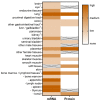Beyond Cancer: Regulation and Function of PD-L1 in Health and Immune-Related Diseases
- PMID: 35955729
- PMCID: PMC9369208
- DOI: 10.3390/ijms23158599
Beyond Cancer: Regulation and Function of PD-L1 in Health and Immune-Related Diseases
Abstract
Programmed Cell Death 1 Ligand 1 (PD-L1, CD274, B7-H1) is a transmembrane protein which is strongly involved in immune modulation, serving as checkpoint regulator. Interaction with its receptor, Programmed Cell Death Protein 1 (PD-1), induces an immune-suppressive signal, which modulates the activity of T cells and other effector cells. This mediates peripheral tolerance and contributes to tumor immune escape. PD-L1 became famous due to its deployment in cancer therapy, where blockage of PD-L1 with the help of therapeutic antagonistic antibodies achieved impressive clinical responses by reactivating effector cell functions against tumor cells. Therefore, in the past, the focus has been placed on PD-L1 expression and its function in various malignant cells, whereas its role in healthy tissue and diseases apart from cancer remained largely neglected. In this review, we summarize the function of PD-L1 in non-cancerous cells, outlining its discovery and origin, as well as its involvement in different cellular and immune-related processes. We provide an overview of transcriptional and translational regulation, and expression patterns of PD-L1 in different cells and organs, and illuminate the involvement of PD-L1 in different autoimmune diseases as well as in the context of transplantation and pregnancy.
Keywords: PD-1–PD-L1 axis; PD-L1; immune checkpoint; non-cancerous tissues.
Conflict of interest statement
The authors declare no conflict of interest.
Figures



Similar articles
-
Regulatory mechanisms of PD-1/PD-L1 in cancers.Mol Cancer. 2024 May 18;23(1):108. doi: 10.1186/s12943-024-02023-w. Mol Cancer. 2024. PMID: 38762484 Free PMC article. Review.
-
PD-1/PD-L1 immune checkpoint: Potential target for cancer therapy.J Cell Physiol. 2019 Feb;234(2):1313-1325. doi: 10.1002/jcp.27172. Epub 2018 Sep 7. J Cell Physiol. 2019. PMID: 30191996 Review.
-
Inhibition of T-cell-mediated immune response via the PD-1/ PD-L1 axis in cholangiocarcinoma cells.Eur J Pharmacol. 2021 Apr 15;897:173960. doi: 10.1016/j.ejphar.2021.173960. Epub 2021 Feb 19. Eur J Pharmacol. 2021. PMID: 33617828
-
Regulation of PD-L1: a novel role of pro-survival signalling in cancer.Ann Oncol. 2016 Mar;27(3):409-16. doi: 10.1093/annonc/mdv615. Epub 2015 Dec 17. Ann Oncol. 2016. PMID: 26681673 Review.
-
Clinical Implications of Exosomal PD-L1 in Cancer Immunotherapy.J Immunol Res. 2021 Feb 8;2021:8839978. doi: 10.1155/2021/8839978. eCollection 2021. J Immunol Res. 2021. PMID: 33628854 Free PMC article. Review.
Cited by
-
CARs and Drugs: Pharmacological Ways of Boosting CAR-T-Cell Therapy.Int J Mol Sci. 2023 Jan 25;24(3):2342. doi: 10.3390/ijms24032342. Int J Mol Sci. 2023. PMID: 36768665 Free PMC article. Review.
-
The role of the immunosuppressive PD-1/PD-L1 checkpoint pathway in the aging process and age-related diseases.J Mol Med (Berl). 2024 Jun;102(6):733-750. doi: 10.1007/s00109-024-02444-6. Epub 2024 Apr 11. J Mol Med (Berl). 2024. PMID: 38600305 Free PMC article. Review.
-
Photoaging: UV radiation-induced cGAS-STING signaling promotes the aging process in skin by remodeling the immune network.Biogerontology. 2025 Jun 20;26(4):123. doi: 10.1007/s10522-025-10268-1. Biogerontology. 2025. PMID: 40542276 Free PMC article. Review.
-
PD-L1 expression and characterization of its carrier macrophages in placentas with acute and specifically post-SARS-CoV-2 infection.Histochem Cell Biol. 2024 Nov 26;163(1):9. doi: 10.1007/s00418-024-02340-7. Histochem Cell Biol. 2024. PMID: 39589546 Free PMC article.
-
Dual-release hydrocortisone treatment improves serum and peripheral blood mononuclear cell inflammatory and immune profiles in patients with autoimmune primary adrenal insufficiency.Front Immunol. 2025 Jan 23;16:1489254. doi: 10.3389/fimmu.2025.1489254. eCollection 2025. Front Immunol. 2025. PMID: 39917303 Free PMC article.
References
-
- Peterson E.J., Maltzman J.S. 12—T-Cell Activation and Tolerance. In: Rich R.R., Fleisher T.A., Shearer W.T., Schroeder H.W., Frew A.J., Weyand C.M., editors. Clinical Immunology. 5th ed. Elsevier; London, UK: 2019. pp. 183–196.e181. - DOI
-
- Wei S.C., Duffy C.R., Allison J.P. Fundamental Mechanisms of Immune Checkpoint Blockade Therapy. Cancer Discov. 2018;8:1069–1086. doi: 10.1158/2159-8290.CD-18-0367. - DOI - PubMed
Publication types
MeSH terms
Substances
Grants and funding
LinkOut - more resources
Full Text Sources
Medical
Research Materials
Miscellaneous

